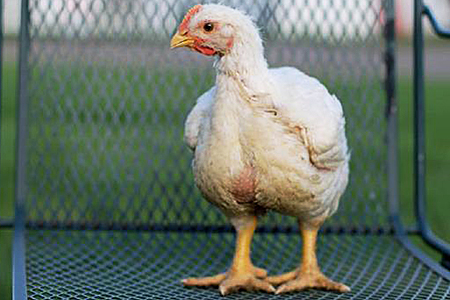
Brooding Cornish cross broilers is similar to brooding any chicks, with the notable exception that the hybrid Cornish broilers get bigger faster. They eat almost constantly, and rarely move far from the feeder. They also drink a lot of water to wash down all that feed. So they need plenty of room to accommodate their rapidly increasing body mass plus feeders and drinkers.
The sheer size of hybrid broilers keeps them warmer than other chicks of the same age. They tend to suffer in hot weather more than most other chicks. In a warm climate they’re best raised during the cooler days of spring or fall. Here are two ways to brood Cornish cross broilers, either indoors or on pasture.
Indoor Confinement
Indoor confinement involves housing the chicks on deep bedding and bringing them everything they eat until they are big enough to go into the freezer at 4 to 10 weeks of age. Confinement requires less land than pasturing. All you need is a sound shelter.
Inside a secure building, broilers are less apt to fall victim to predators. Managing them also requires less time. Once the facility is set up, it takes only a few minutes a day to feed, water, and check the chicks. This method especially suits white Cornish hybrids, because they don’t move around much anyway.
Each broiler needs about one-half square foot up to the age of 2 weeks, increased to 2 to 3 square feet by the time the birds are ready for harvest. Accordingly, an 8-foot by 8-foot shed will accommodate about 25 broilers.
Do not provide roosts. Leg injuries can occur when these heavy birds jump down from a roost. Perching can also cause breast blisters and crooked breastbones. To avoid such issues, provide broilers with deep, soft, dry bedding.
Pasture Confinement
Like indoor confinement, pasture confinement involves keeping broilers inside a shelter that includes a feeder and drinker. But this shelter is portable, has no floor, and is moved daily to give the chicks fresh forage.
Cornish hybrids become pen potatoes unless they are introduced to forage no older than 3 weeks of age. Weather permitting, they may be moved outdoors as young as 2 weeks of age. White Cornish don’t do well on pasture if the weather is much cooler than 65°F or much warmer than 85°F.
Broilers with access to grass produce meat that contains less fat and more omega-3s and other good nutrients. Another upside of pasture confinement is a slight reduction in feed costs, especially if you move the shelter first thing each day to encourage hungry birds to forage before feeding the morning ration.
On the downside, you need enough good pasture to move the shelter to new ground daily. And without fail you must do it every day.
The older the broilers get, the faster they graze down plants and the more droppings they deposit each day. So, as they grow, they must be moved more often — at least twice a day — for their own health and that of the pasture.
A movable pasture shelter may be made of hardware cloth stapled to a pressure-treated wood frame and roofed with a tarp or corrugated aluminum. Lightweight ready-made pasture shelters are also available. Using the typical proportion of 1.2 square feet of pen space per bird, a 4-foot by 8-foot pasture shelter — the size of a standard camper shell — will accommodate about 25 broilers.
The shelter may be fitted with wheels to be moved by one person, or with strategically placed handles for two or more people. During the first few moves, the birds will be reluctant to follow their floorless shelter. Eventually they learn to walk along with the shelter, because they know a fresh salad is on the way.
Among the many reasons to raise Cornish cross broilers is that they will fill your freezer with meat faster than any other livestock. With surging interest in backyard food production, sparked by the COVID-19 pandemic, Cornish cross broiler chickens should be at the top of everyone’s list for homegrown meat.
And that’s today’s news from the Cackle Coop.
Gail Damerow, author, Storey’s Guide to Raising Chickens.

